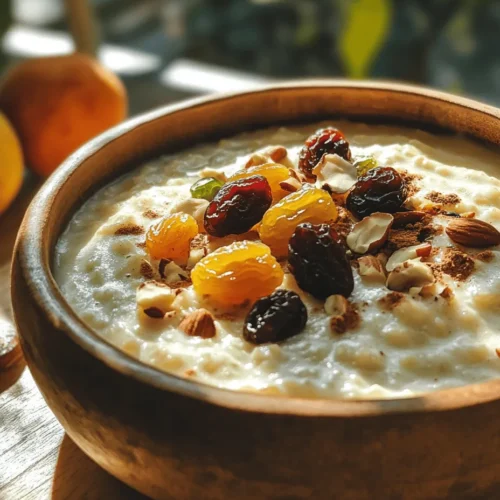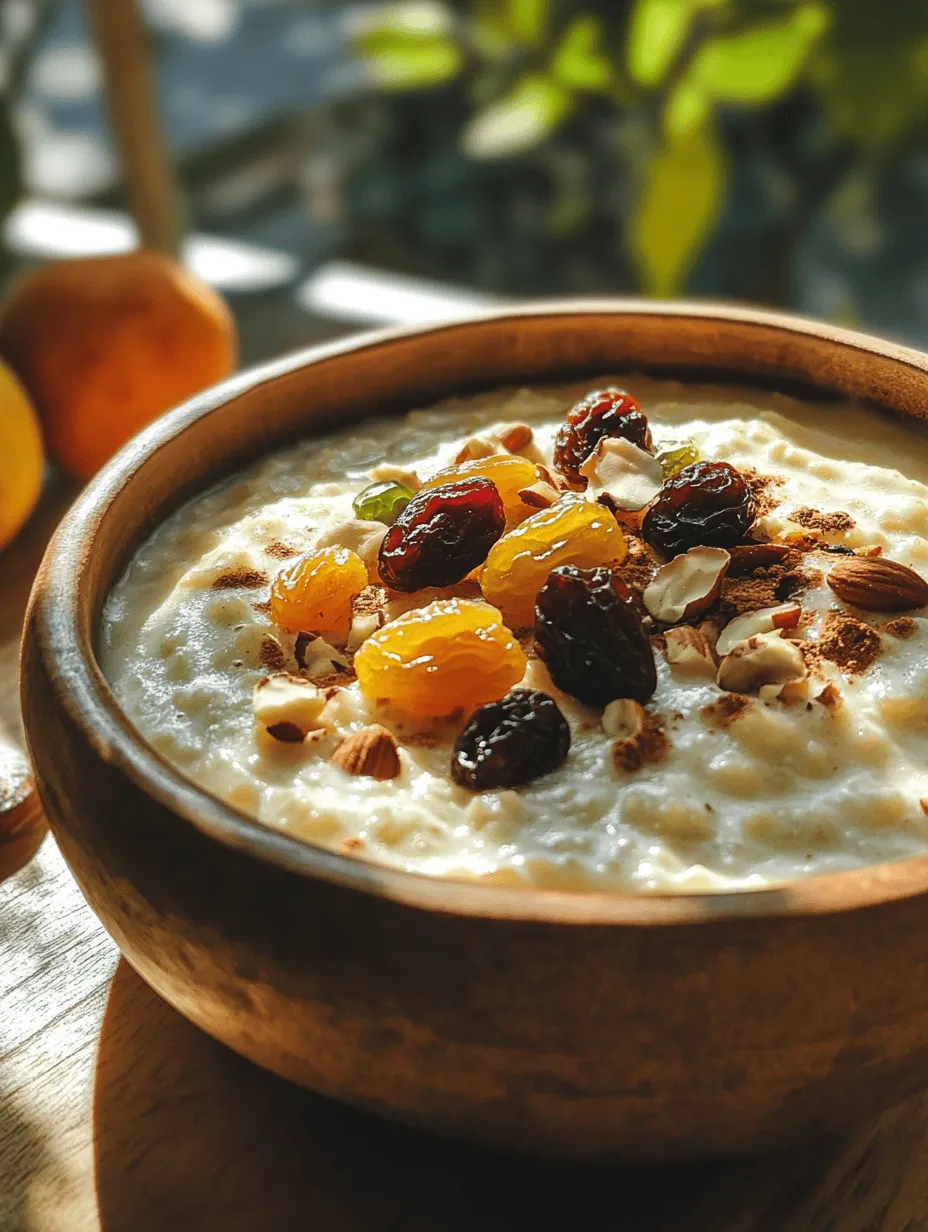Introduction
There’s something undeniably comforting about a warm bowl of rice pudding, a dessert that not only satisfies our sweet tooth but also evokes nostalgic memories of home and family gatherings. Rice pudding is more than just a simple dessert; it’s a dish that has been cherished across generations and cultures, bringing a sense of warmth and comfort to those who indulge in it. With its creamy texture and sweet, aromatic flavor, rice pudding stands out as a timeless classic that can be enjoyed by people of all ages.
The secret to achieving the ultimate rice pudding lies in using high-quality ingredients that elevate the dish to new heights. Each component contributes to the overall flavor profile and texture, transforming a basic recipe into something truly heavenly. In this article, we will introduce you to our featured recipe: Heavenly Creamy Rice Pudding. This version not only captures the essence of traditional rice pudding but also enhances it with a few special techniques and ingredients that ensure a rich, velvety dessert you’ll want to make again and again.
Understanding Rice Pudding
Rice pudding has a rich historical significance that spans across various cultures, making it a beloved dessert around the world. From the creamy rice puddings of Europe to the sweet and spiced versions found in Asia, this dish has taken on many forms and flavors. The origins of rice pudding can be traced back to ancient civilizations, where rice, a staple food, was combined with milk and sweeteners to create a nourishing dish. Over the centuries, rice pudding has evolved, adapting to local ingredients and culinary traditions, which has led to a delightful array of variations.
For instance, in Italy, you may find “risotto al latte,” a creamy rice pudding flavored with lemon zest and served as a dessert. In India, “kheer” is a popular version made with basmati rice, flavored with cardamom, and often garnished with nuts and dried fruits. Similarly, in the Middle East, rice pudding is often infused with rose water and served chilled as a refreshing treat. This versatility makes rice pudding not only a comforting dessert but also a delightful exploration of global cuisine.
Why is rice pudding so universally loved? Perhaps it is the creamy texture that envelops the palate or the sweetness that warms the heart. It’s a dish that can be enjoyed warm or cold, making it suitable for any season. Whether served as a comforting dessert after a hearty meal or as a sweet treat on a chilly evening, rice pudding has earned its place in the hearts and homes of many.
Key Ingredients and Their Roles
To create a truly heavenly rice pudding, it’s essential to focus on the key ingredients that contribute to its flavor and texture. Here’s a breakdown of the essential components and their roles in this creamy delight:
Arborio Rice
The star of the show is, of course, the rice itself. For this recipe, we recommend using Arborio rice, a short-grain rice known for its high starch content. This characteristic is crucial, as it allows the rice to absorb liquid while releasing starch, resulting in a creamy, luscious texture. Unlike long-grain rice varieties, which can be dry and separated, Arborio rice becomes plump and creamy during the cooking process, making it ideal for rice pudding.
Whole Milk
Whole milk plays a pivotal role in achieving the desired creaminess of the pudding. The fat content in whole milk not only thickens the mixture but also enhances the overall flavor, creating a rich, indulgent dessert. While some may opt for lower-fat alternatives, using whole milk is highly recommended for the best results.
Sugar, Vanilla Extract, and Spices
Sweetness is key in rice pudding, and that’s where sugar comes into play. Granulated sugar is the most common choice, providing the right level of sweetness to balance the dish. Additionally, a splash of vanilla extract adds a lovely aromatic quality that elevates the flavor profile.
Spices like cinnamon and a pinch of salt are also essential. Cinnamon infuses the pudding with warmth and depth, while salt enhances the overall sweetness and flavor complexity. Together, these elements create a harmonious blend of flavors that will make your taste buds rejoice.
Heavy Cream
While optional, heavy cream can be added for an extra layer of richness. If you want to take your rice pudding to the next level of indulgence, incorporating heavy cream during the cooking process will enrich the texture and flavor, making it even more decadent.
Topping Options
To finish off your Heavenly Creamy Rice Pudding, consider topping it with fresh fruits, raisins, or nuts. Berries add a refreshing burst of flavor, while raisins provide a chewy sweetness. For added crunch, chopped nuts like almonds or pistachios can be sprinkled on top, offering a delightful contrast to the creamy pudding.
Step-by-Step Guide to Making Heavenly Creamy Rice Pudding
Preparing the Rice
Before you begin cooking, it’s crucial to prepare the rice properly. Rinsing Arborio rice removes excess starch and prevents the pudding from becoming overly gummy. To do this, place the rice in a fine-mesh strainer and rinse it under cold water until the water runs clear. This step will help ensure that your rice pudding has a smooth, creamy texture without clumping.
Cooking the Rice
Once the rice is rinsed, it’s time to cook it. In a medium saucepan, combine the rinsed Arborio rice with water and a pinch of salt. Bring the mixture to a gentle boil over medium heat, then reduce the heat to low, cover, and let it simmer. Cooking the rice in water first allows it to absorb the moisture and soften before the addition of milk. This step is key to achieving the perfect texture.
Simmer the rice for about 15 minutes or until it is tender and has absorbed most of the water. Stir occasionally to prevent sticking. Once the rice is cooked, it’s time to add the milk and sweeteners.
Incorporating Milk and Sweeteners
After the rice has absorbed the water, gradually add the whole milk to the saucepan. The amount of milk you use may vary depending on your desired consistency; for a thicker pudding, use less milk, and for a creamier texture, add more. Stir in the granulated sugar and vanilla extract, ensuring they dissolve completely into the mixture.
Continue to cook the rice and milk mixture over low heat, stirring frequently. This step is essential for achieving the right consistency and preventing the pudding from sticking to the bottom of the pan. Keep an eye on the pudding as it cooks, allowing it to simmer gently for about 20-25 minutes. The rice will continue to absorb the milk, thickening into a creamy dessert.
The Art of Stirring
Stirring is not just a simple task; it’s an art form in the process of making rice pudding. Constant stirring helps to release the starch from the rice, creating a smooth, creamy texture. It also prevents the rice from settling at the bottom of the pan and scorching. As you stir, you’ll notice the pudding gradually thickening; this is your cue to adjust the cooking time based on your preferred consistency. If you like your rice pudding on the thicker side, allow it to simmer a little longer, but be sure to keep stirring!
—
This introduction and initial step guide sets the stage for the rich, comforting experience that Heavenly Creamy Rice Pudding delivers. With its historical significance, key ingredient insights, and essential cooking techniques, this recipe promises to be a delightful addition to your dessert repertoire. As you embark on this culinary adventure, you’ll discover the joy of creating a dish that not only nourishes the body but also warms the soul.

Adding Flavor: Timing for Incorporating Vanilla Extract
One of the key secrets to achieving a heavenly creamy rice pudding is the timing of when you add your vanilla extract. To maximize the flavor and aroma, it’s best to add the vanilla extract during the last few minutes of cooking. This allows the essence to infuse into the pudding without being subjected to prolonged heat, which can diminish its aromatic qualities. As the pudding thickens and reaches a creamy consistency, stir in about 1 to 2 teaspoons of pure vanilla extract. This simple addition will elevate your rice pudding, giving it a rich and comforting flavor that pairs beautifully with its creamy texture.
Serving Suggestions: Best Practices for Serving and Garnishing
Once your rice pudding is ready, the next step is to serve this delightful dessert in a way that enhances its appeal. Here are some best practices for serving:
1. Dish Selection: Choose shallow bowls or dessert cups that allow for a generous serving of rice pudding. Glassware can add an elegant touch, showcasing the creamy texture and garnishes.
2. Temperature: Rice pudding can be served warm, at room temperature, or chilled. If you prefer it warm, serve it immediately after cooking. For those who enjoy it chilled, allow it to cool to room temperature before refrigerating for at least two hours.
3. Garnishing: A simple sprinkle of cinnamon or nutmeg on top can add a touch of warmth and spice. Fresh fruit, such as sliced strawberries, blueberries, or a dollop of fruit compote, can add a burst of color and flavor. For a luxurious finish, consider adding a swirl of whipped cream or a drizzle of caramel sauce.
Tips for Customization
Rice pudding is a versatile dessert that can be easily customized to suit various tastes and dietary needs. Here are some ideas to enhance your rice pudding experience:
– Exploring Different Flavor Profiles: Beyond vanilla, consider adding citrus zest, such as orange or lemon, to the cooking process. This brightens the flavor profile and adds a refreshing element to the creamy dish. A pinch of nutmeg can also introduce a warm spice that complements the sweetness of the pudding beautifully.
– Alternatives for Dietary Restrictions: For those looking for dairy-free options, substitute regular milk with almond milk, coconut milk, or oat milk. These alternatives not only cater to dietary needs but also introduce unique flavors that can enhance your rice pudding.
– Suggestions for Seasonal Fruit Toppings: Depending on the time of year, consider using seasonal fruit toppings. Fresh peaches in the summer, apples in the fall, or even pomegranate seeds in the winter can bring a delightful twist to your dish. You can also sauté fruits lightly in a bit of butter and sugar to create a delicious topping that pairs perfectly with the creamy pudding.
Nutritional Considerations
Understanding the nutritional content of your rice pudding can help you enjoy this dessert guilt-free. Here’s a breakdown of calories and nutritional content per serving:
– Calories: A typical serving of homemade rice pudding contains approximately 150 to 200 calories, depending on the ingredients used, such as the type of milk and the amount of sugar.
– Nutritional Benefits: Using whole ingredients, such as brown rice and natural sweeteners, can enhance the nutritional value of your pudding. Brown rice is a great source of fiber, while milk provides calcium and protein. Opting for unsweetened almond or coconut milk can reduce calorie content while still providing a creamy texture.
– Balancing Indulgence with Nutrition: While rice pudding is inherently a sweet treat, using natural sweeteners like honey or maple syrup in moderation can help balance indulgence with health benefits. This approach allows you to enjoy your dessert while still being mindful of your overall nutrition.
Common Mistakes to Avoid
Creating the perfect rice pudding requires attention to detail, and avoiding common mistakes can make all the difference:
– Overcooking vs. Undercooking: One of the biggest challenges is achieving the right consistency. Overcooking can lead to a dry and clumpy pudding, while undercooking may result in a watery texture. The ideal rice pudding should have a creamy consistency, so keep an eye on the cooking time and do a taste test to ensure the rice is tender yet retains its shape.
– Importance of Stirring: Stirring frequently during the cooking process is crucial. This prevents the rice from sticking to the bottom of the pot and burning, which can ruin the dish. A gentle stir every few minutes will help maintain an even consistency and avoid any unpleasant scorched flavors.
– Adjusting Sweetness: Sweetness is subjective, so it’s essential to taste your rice pudding as it cooks. Start with a smaller amount of sugar, and gradually add more until it reaches your desired sweetness. This method allows for a customized dessert that caters to your personal preferences.
Storing and Reheating Rice Pudding
If you have leftovers (which is often the case with this delicious dessert), proper storage and reheating methods are important to maintain its creamy texture:
– Best Practices for Storing Leftovers: Store leftover rice pudding in an airtight container in the refrigerator. It can be kept for about 3-4 days. To prevent a skin from forming on top, cover the surface of the pudding with plastic wrap before sealing the container.
– How to Reheat Rice Pudding: When reheating, do so gently to avoid curdling the milk. Place the desired portion in a saucepan over low heat, stirring frequently, and add a splash of milk or water to restore creaminess. Alternatively, you can microwave it in short intervals (30 seconds at a time), stirring in between, until heated through.
– Creative Ways to Repurpose Leftover Rice Pudding: If you find yourself with extra rice pudding, consider transforming it into new desserts. Layer it with granola and fresh fruit for a parfait, or use it as a filling for crepes. You can also mix it with a bit of cocoa powder to create a chocolate version, enticing those who crave a chocolatey treat.
Conclusion
In summary, making heavenly creamy rice pudding is not only a satisfying cooking endeavor but also a delightful experience that brings warmth and comfort. From the careful timing of adding vanilla extract to the thoughtful selection of garnishes and toppings, each step contributes to a final dish that is both rich in flavor and texture.
Encouragement to try this recipe is not just about the joy of creating something delicious; it’s about sharing that joy with loved ones. Whether served as a comforting dessert after a meal or enjoyed as a sweet treat during special occasions, rice pudding has a way of bringing people together.
As you embark on your rice pudding journey, remember that homemade desserts hold a special place in our hearts. They remind us of cherished memories and the simple pleasure of enjoying something made with love. So gather your ingredients, follow the steps, and savor the delightful experience of crafting this timeless dessert in your own kitchen.



